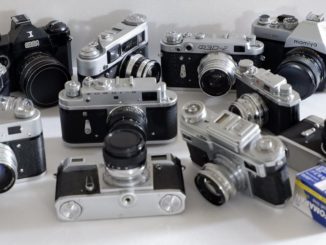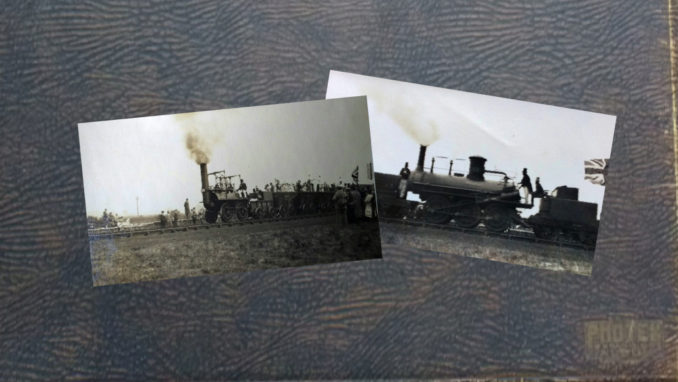
A mystery album has fallen into my possession presenting a number of fascinating puzzles and thus far unanswered questions. Featuring a family, most certainly of wealth and importance, no captions are written beneath or on the reverse of the conscientiously presented sepia images. What I can say with certainty is that over the next few weeks the combined observational powers of the Puffinatti will provide answers. But first, let’s have some fun with the train photos to be found at the midway point between the near hundred-year-old Photex Expandbale’s covers.
The first photograph shows an old engine pulling railway wagons, emblazoned with the letters ‘S&DR’, full of brave passengers open to the elements in late Georgian dress. Note the giant and rather crude brake between the wheels of the first wagon behind the engine.

Even the most rudimentary knowledge of railways suggests this to be the Stockton and Darlington Railway, the world’s first steam-powered public railway which opened in 1825. At that opening, travellers dressed in their finest were carried in open S&DR coal hoppers along the line. Forty thousand lined the route to witness the spectacle. Excellent! Case closed. However, although train buffs are well known for the early adoption of technology to enhance their hobby (you could drive a train on your ZX81), all of this was happening just before the French claim a chap called Joseph Nicéphore Niépce invented the camera.
The eagle-eyed will also have spotted that the proceedings don’t include the obligatory 1825 man on a leading horse waving a red flag.
Two minutes on Google revealed that in 1925 a centenary procession was held, self evidently captured by a mystery photographer to a thus far unknown respectable family’s album. We are off to a good start. A good start that was not to last. As the pages turned the mystery deepened. But for the time being, let’s just enjoy the trains.
Our friends at between the wars masterpiece Railway Wonders of the World, who have been helpful elsewhere on GP as we traverse the railways of the Levant and Asia Minor on the Berlin to Baghdad Railway, were on hand to immortalise the cavalcade in their contemporary article, ‘Railway Centenary Celebrations: Contrast of old and new.’
Although the Stockton and Darlington line opened on 27th September 1825, the centenary was celebrated in July 1925 to allow delegates from an international railway congress being held in London to travel north. They were joined by the editor of Railway Wonders who, on arrival in Darlington, noted the following,
When I arrived in Darlington I found the town “en fete” – the streets were gaily decorated with flags and bunting, the shops were closed, and everyone seemed to be having a holiday in honour of the event. There were special bands and entertainments in the public parks, and everything possible was being done to make the anniversary an event to be remembered – more especially, perhaps, by the boys and girls.
Everywhere one saw evidence of the spirit of the week – in the Park, for instance, was a huge flower-bed designed in the form of a locomotive, with a suitable floral inscription “Centenary: 1825 – 1925”. Almost every shop window was suitably set out – there were locomotives in cardboard, in soap, in chocolate, and even in fruit; old prints dealing with early railways and dozens of books – old and new – on locomotives and railways. Even the hatters and tailors entered into the spirit of the thing and displayed in their windows hats and suits of the period, as worn by the passengers of the trains of a century ago.
Then and now, the rivet counters walk among us. I have dabbled myself. At times I have been an over-enthusiastic member of their tribe. As I provide thumbnail descriptions to accompany the photographs, I apologize in advance for all my mistakes.
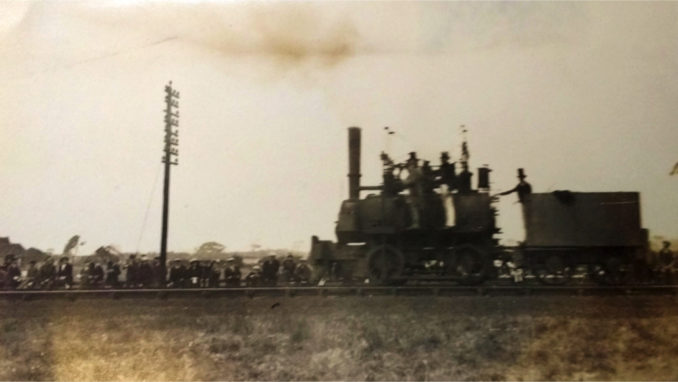
Despite the order in the album, the centeneary procession was led by the Hetton Colliery locomotive. Built in 1822 at the Hetton Colliery workshops by George Stephenson, she was subsequently re-built in 1857 and 1882 before being withdrawn in 1912, after 90 years in service. The gentleman in the top hat is the driver, that being a posh but outdoor job in those days. The locomotive proceeded at a stately 6 mph, a reminder that originally the 12 miles between Stockton and Darlington took two hours to traverse.

Next came the Derwent. An 0-6-0 mineral engine built in 1845 by Wm and Alf Kitching at Hopetown Foundry, Darlington. It worked the S&DR until being sold to Peases’ West Collieries at Crook. The chap in the top hat, white trousers, frock coat and tails is driver George Danby, again wearing the locomotive engineer’s uniform of the times.
Although Railway Wonders describes the engine as ‘typical’ it is noticeable that the firebox is at the front of the engine and the tender, therefore, precedes the rest of the train. The fireman and driver are separated by the length of the boiler. Typical for its day might have been a better way of putting it.
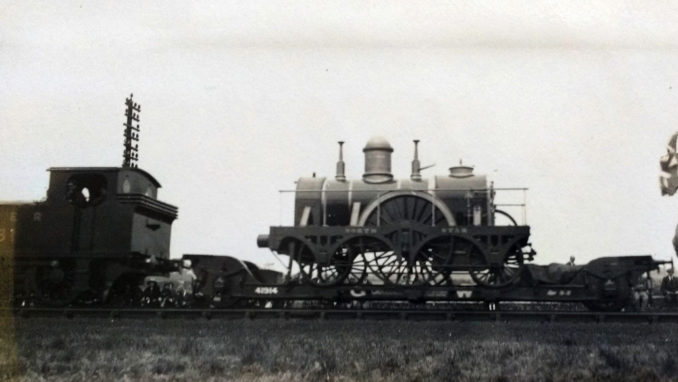
The next part of the cavalcade featured a replica of North Star. The original 6ft gauge 2-2-2 was built by Robert Stevenson & Co in 1837 and was intended for a foreign railway. It was converted to 7-foot and a quarter inch gauge for use on Brunel’s Great Western and remained in traffic until 1870.
It is being hauled on a crocodile flat by an NER E1 tank engine. After the First World War, the railway industry was reorganised into a smaller number of bigger companies via the Railway Grouping Act of 1921. The railways being grouped in 1923. With this exhibition taking place in 1925, numbers, classes, railway companies and liveries are a bit fluid. What the editor of Railway Wonders calls an NER E1 the rest of us would probably call an LNER J72. Despite what you can see with your own eyes, it says LNER on the side and I would guess at the number being 8114. I’m probably wrong.
At this point, the order in the album parts company with the order in Railway Wonders. For ease, I will persist with album order but not before introducing some VIPs.
The guests of honour at the centenary celebrations were the Duke and Duchess of York who, unbeknown at the time, were to become King George VI and the Queen Mother. They were shown around the Faverdale railway workshops at Darlington by Sir Nigel Gresley, the legendary Chief Mechanical Engineer of the LNER, before being taken by car to a grandstand beside the line.

Back in the procession, albeit in photo album order, we see the Great Northern Railways’ Locomotive No. 1, a Stirling Single class 4-2-2. Notable and named because of its single pair of 8’1″ driving wheels and because it was designed by Patrick Stirling. Built at Doncaster in 1870, No.1 is still with us and is part of the National Railway Museum exhibition in York.
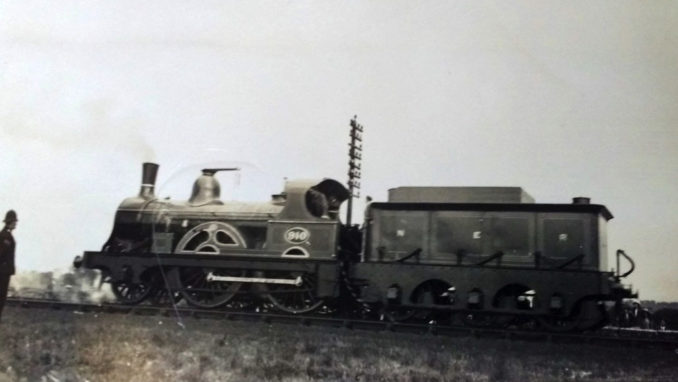
Railway Wonders describes 910 thus,
Next we saw LNER No. 910 (2-4-0) built in 1875 at Gateshead, an Express Passenger loco of a type used for working the principal trains between Newcastle and Edinburgh and also between Edinburgh and York. This loco took part in the Newark Brake Trials of 1875 and was also included in the Jubilee celebrations of the Stockton and Darlington Railway in the same year.
910 left service in 1926 and is preserved at Shildon, in NER green. Why have so many of these engines survived? Because they were in the cavalcade because of their historical importance. No. 910 went from service to the LNER’s museum which opened in York in 1928. As early as 1860, the Patent Office had been bagsing old engines for its collection which was to become the basis of the Science Museum.

1275 is a Class 1001 long boiler 0-6-0 designed by William Booch for the North East Railway and built in Glasgow by Dubs & Co in 1874. 192 examples were constructed, the last of which left service in 1923, just before the parade. 1275 has also survived and is preserved at the National Railway Museum in York resplendent in North East Railway green with red buffer beam.

This had me baffled. A firm believer in ‘say what would see’, I was going to caption it as a self-propelled eleven plank brake van before Railway Wonders came to the rescue to inform me that it’s 7133 an 0-4-0 Great Eastern shunting engine built in 1897.
The type was first introduced in 1883 and is used chiefly for shunting and working trains on public highways, docks, and quaysides.
Equipped with a number, further investigation showed it to be a Thomas William Wordsell design built at Stratford Works, which is now underneath the Westfield shopping centre in East London. Seen above in its LNER livery, some examples survived into British Rail ownership (1948), the last one being withdrawn in 1952. I am one of those people who detests Thomas the Tank Engine with a venom that is difficult to quantify. A friend tells me 7133 is the prototype for Toby the Tram Engine. Meh.
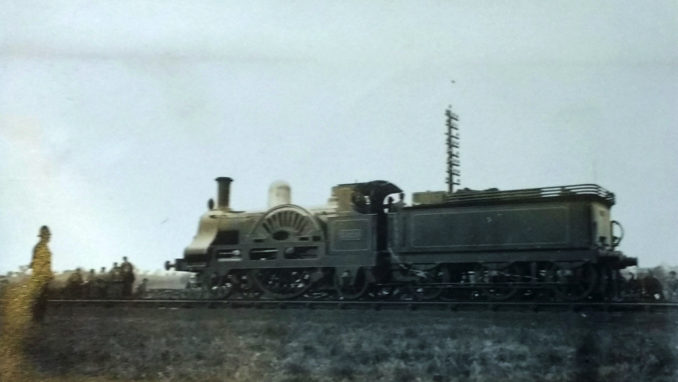
This is Cornwall, No. 3020 of the London and North Western Railway. Designed by Francis Trevithick it was built at Crewe in 1847, originally as a 4-2-2. Not withdrawn until the year of the exhibition, 1925, it was in service for 78 years albeit having been rebuilt as a 2-2-2 in 1858. It is famous for having, at 8′ 6″, the largest diameter driving wheels of any single. No. 3020 is also preserved, also at Shildon where she is displayed in magnificent LNWR black with red piping and gleaming copper top.
Francis Trevthick was the son of Richard Trevithick the pioneering engineer who realised that stationary steam engines used for pumping water out of the copper and tin mines in his native Cornwall could be made to self-propel and haul.
In 1804 the world’s first locomotive hauled railway journey took place along a tramway at the Penydarren Ironworks in Merthyr Tydfil. Twenty one years later, the S&DR became the first public railway to use steam locomotion.
***
Turning the page revealed more surprises, which we shall explore in the next edition of Mystery Album.
© Text and photographs Always Worth Saying 2021
The Goodnight Vienna Audio file
Audio Player



